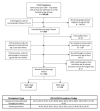Single-stage versus multi-stage pull-through for Hirschsprung's disease: practice trends and outcomes in infants
- PMID: 25475806
- PMCID: PMC4257999
- DOI: 10.1016/j.jpedsurg.2014.06.002
Single-stage versus multi-stage pull-through for Hirschsprung's disease: practice trends and outcomes in infants
Abstract
Purpose: The aim of this study was to evaluate surgical treatments and outcomes in a multi-institutional cohort of neonates with Hirschsprung's disease (HD).
Methods: Using the Pediatric Health Information System (PHIS) from 1999 to 2009, neonates diagnosed with HD were identified and classified as having a single stage pull-through (SSPT) or multi-stage pull-through (MSPT). Diagnosis and classification algorithms and clinical variables and outcomes were validated by multi-institutional chart review. Groups were compared using logistic regression modeling and propensity-score matched analysis to account for baseline differences between groups.
Results: 1555 neonates with HD were identified; 77.2% underwent SSPT and 22.8% underwent MSPT. Misclassification of disease or surgical treatment was <2%. Rates of SSPT increased over time (p=0.03). Compared to SSPT, patients undergoing MSPT had significantly lower birth weights and higher rates of prematurity, non-HD gastrointestinal anomalies, enterocolitis, and preoperative mechanical ventilation. Patients undergoing MSPT had significantly higher rates of readmissions (58.5 vs. 37.9%) and additional operations (38.7 vs. 26%). Results were consistent in the propensity-score matched analysis.
Conclusion: Most neonates with HD undergo SSPT. In patients with similar observed baseline characteristics, MSPT was associated with worse outcomes suggesting that some infants currently selected to undergo MSPT may have better outcomes with SSPT. However, there remains a subgroup of MSPT patients who were too ill to be adequately compared to SSPT patients; for this subgroup of severely ill infants with HD, MSPT may be the best option.
Keywords: Hirschsprung's disease; Multi-stage pull-through; Outcomes; PHIS; Pediatric Health Information System; Primary pull-through; Single stage pull-through.
Copyright © 2014 Elsevier Inc. All rights reserved.
Figures


References
-
- Huang EY, Tolley EA, Blakely ML, et al. Changes in hospital utilization and management of Hirschsprung disease: analysis using the kids’ inpatient database. Annals of Surgery. 2013 Feb;257(2):371–375. - PubMed
-
- So HB, Schwartz DL, Becker JM, et al. Endorectal “pull-through” without preliminary colostomy in neonates with Hirschsprung’s disease. Journal of Pediatric Surgery. 1980 Aug;15(4):470–471. - PubMed
-
- Carcassonne M, Guys JM, Morrison-Lacombe G, et al. Management of Hirschsprung’s disease: curative surgery before 3 months of age. Journal of Pediatric Surgery. 1989 Oct;24(10):1032–1034. - PubMed
-
- Cilley RE, Statter MB, Hirschl RB, et al. Definitive treatment of Hirschsprung’s disease in the newborn with a one-stage procedure. Surgery. 1994 May;115(5):551–556. - PubMed
-
- Langer JC, Fitzgerald PG, Winthrop AL, et al. One-stage versus two-stage Soave pull-through for Hirschsprung’s disease in the first year of life. Journal of Pediatric Surgery. 1996 Jan;31(1):33–36. discussion 36–37. - PubMed
Publication types
MeSH terms
Grants and funding
LinkOut - more resources
Full Text Sources
Other Literature Sources
Medical

